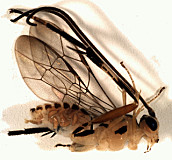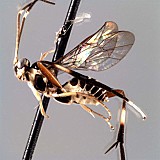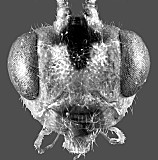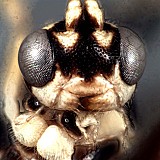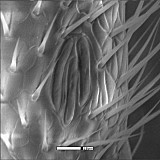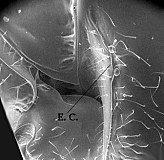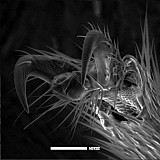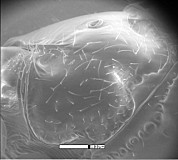Catucaba Graf, Kumagai & Dutra, 1991
Type species: Catucaba anaterrae Graf, Kumagai, and Dutra, 1991, by monotypy.
Yu and Horstmann 1997: 454 (catalog).
Zhaurova and Wharton 2009: 21-25, 69-77 (redescription of genus, new species, generic key, analysis of relationships).
In addition to features of the clypeus, Catucaba is distinctive in several respects, and is thus perhaps the best characterized genus of Scolobatini. The face is unusually bulging dorsally, with the lower face and clypeus appearing concave as a result. The dorsal median tubercle just below the antenna also appears to be absent, perhaps as a result of the larger bulge in the same general area. In Catucaba, cross-vein r-m in the hind wing arises from M basal to the origin of Rs, an unusual feature in Ichneumonidae. Additionally, the epicnemial carina extends forward to the anterior margin of the mesopleuron unlike the condition in other known scolobatines, and the hind trochanter is unusually long and slender.
There are no specimens currently determined for this OTU, or those specimens determined for this OTU are not yet mappable.
This work owes much to the groundwork provided by Ian Gauld’s study of the Australian and Costa Rican faunas, and we are particularly grateful for his assistance in many aspects of this study. We also thank the following curators and researchers for extended loans of the material used for the revision of Scolobatini and Westwoodiini: David Wahl (AEIC), Ian Gauld and Gavin Broad (BMNH), Andy Bennett (CNC), and Gabriel Melo (DZUP). Matt Yoder provided considerable assistance along the way, particularly with databasing. Images used here were obtained through the combined efforts of Kira Zhaurova, Heather Cummins, and Patricia Mullins. Our use of PURLs (http://purl.oclc.org) follows the example of their use in publications by Norm Johnson. This content is based upon work conducted at Texas A&M University and supported by the National Science Foundation’s PEET program under Grant No. DEB 0328922 and associated REU supplement nos DEB 0723663 and DEB 0616851.
This material is based upon work supported by the National Science Foundation under Grant Number DEB 0328922 with REU supplements DEB 0723663 and 0616851.
Any opinions, findings, and conclusions or recommendations expressed in this material are those of the author(s) and do not necessarily reflect the views of the National Science Foundation.

